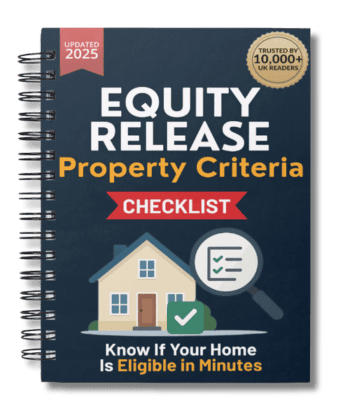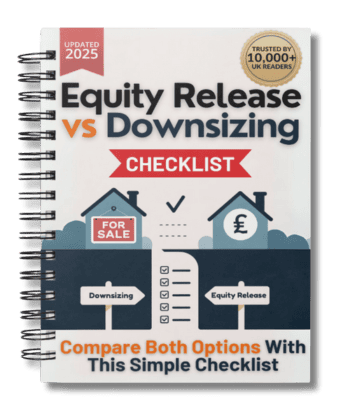
Equity Release: What You Need to Know in 2025
 Be aware. Equity release comes with drawbacks which are important to think about. Lifetime mortgages are secured loans. Compound interest means the amount you owe can grow quickly. Equity release reduces your estate's value and may impact means-tested benefits.
Be aware. Equity release comes with drawbacks which are important to think about. Lifetime mortgages are secured loans. Compound interest means the amount you owe can grow quickly. Equity release reduces your estate's value and may impact means-tested benefits.Key Takeaways
- Equity release is available to homeowners aged 55+ via lifetime mortgages or home reversion plans.
- You retain the right to live in your home while accessing a portion of its value as tax-free cash.
- Eligibility depends on age, property type, and value; affordability checks are not usually required.
- Interest compounds over time and is repaid when the property is sold after death or long-term care.
- Equity release can affect means-tested benefits and reduce your estate’s value.
- All plans are FCA-regulated and often carry Equity Release Council safeguards.
- Comparing plans and providers is essential to secure competitive rates and suitable features.
- Alternatives like downsizing or retirement interest-only mortgages may be worth considering.
- For a full breakdown of costs, visit the Equity Release Costs Checklist.
In 2023, around 50,000 British homeowners over 55 opted for equity release.1
While it is a popular choice for accessing home value, it comes with risks such as reducing your estate’s value, and may not suit everyone.
Before committing, research carefully, seek expert advice, and consider the pros and cons of this type of loan.
In This Article, You Will Discover:
Our goal is to provide a comprehensive equity release guide so you can find it easier to make informed decisions.
At EveryInvestor, we are committed to maintaining the highest standards of accuracy and comprehensiveness.
Our researchers have analysed all the latest equity release news, statistics, facts and industry updates. Our editorial team reviews, fact-checks, and updates all our content to remain current, and relevant.
Keep reading to find out what you need to know.
What Is Equity Release and How Does It Work?
Equity release lets you access tax-free cash from your home, usually through a lifetime mortgage or home reversion plan. With a lifetime mortgage, you borrow against your property’s value and repay the loan (plus interest) when you pass away or move into long-term care. Home reversion involves selling a share of your property for a lump sum or regular payments, while retaining the right to live in your home for life.
For a detailed breakdown of costs and considerations, see the Equity Release Costs Checklist.
The Equity Release Process: Step-by-Step

The process of releasing equity from your home involves several key steps:
- Seek Advice: Consult an FCA-authorised equity release adviser to assess your needs and explore options. They will recommend a suitable product from an Equity Release Council member.
- Application: Your adviser submits your application to the chosen provider.
- Property Valuation: A qualified surveyor values your property.
- Offer Acceptance: If approved, you receive an offer via your solicitor. Upon acceptance, you sign the agreement, and your solicitor registers the loan with the Land Registry.
- Funds Released: You receive your funds as a lump sum, regular payments, or both.
How Much Can You Release? Rates and Costs in 2025
The amount you can release depends on your age, property value, and health. Interest rates in July 2025 typically range from 6.07% to 7% (MER), with the lowest rates for older applicants and higher-value properties.
Key costs to consider:
- Arrangement, valuation, and legal fees (usually £1,500–£3,000)
- Early repayment charges if you settle the loan early
- Compound interest, which can significantly increase the total owed
For the latest rates, visit the Equity Release Interest Rates page.

Examples of Equity Release in Practice
Consider a homeowner aged 70 with a house valued at £300,000. Using a lifetime mortgage, they might release £100,000 to renovate their home and supplement their retirement income. The loan accumulates interest but is only repaid when the house is sold, usually after death or moving into long-term care.
Another example could involve using equity release to help family members. A 65-year-old may choose to release a portion of their home’s value to provide a deposit for their child’s first home. The flexibility of equity release allows for financial support while retaining homeownership.
Lifetime Mortgages vs Home Reversion Plans
Lifetime Mortgages:
- Borrow against your home’s value while retaining ownership.
- Access equity as a lump sum or in smaller amounts.
- Interest is rolled up and repaid when the property is sold.
Home Reversion Plans:
- Sell part or all of your home to a provider at below market value.
- Receive a lump sum or regular payments.
- Lose sole ownership of your property.
Eligibility Criteria for Equity Release

To qualify for equity release in 2025, you typically need to:
- Be at least 55 years old
- Own your home outright or have a small remaining mortgage
- Use the property as your main residence
- Have a property worth at least £70,000
- Have no more than two names on the title deed
Additional criteria may apply depending on the plan and provider.
Uses and Alternatives for Over 55s

Equity release can be used for:
- Paying off mortgages
- Boosting retirement income
- Supporting family members
- Meeting care-related expenses
Alternatives include:
- Downsizing
- Remortgaging
- Using savings or other credit facilities
- Applying for benefits
- Taking out a Retirement Interest-Only (RIO) mortgage
For more on alternatives, see Retirement Interest-Only Mortgages.
Financial Impact: Interest, Repayment, and Inheritance
Equity release affects your estate’s value and may impact means-tested benefits. Compound interest can significantly increase the total owed, and early repayment charges may apply.
Inheritance:
- Equity release reduces the value of your estate.
- Some plans offer inheritance protection.
- For more on inheritance, see How Does Inheritance Protection Work with Equity Release?.
How Safe Is Equity Release in 2025?
Equity release is regulated by the FCA and most plans are covered by the Equity Release Council, which provides safeguards such as:
- No negative equity guarantee (you’ll never owe more than your home’s value)
- Fixed or capped variable interest rates
- Transparent communication and consumer protection standards
For more on safety, visit the Equity Release Council.
Comparing Providers and Plans
Comparing plans and providers is essential to find the best rates and features. Use online calculators and consult advisers to compare offers.

Top providers in 2025 include:
- Aviva
- Canada Life
- LV=
- Responsible Life
- More2Life
- Nationwide Lifetime Mortgage
- Just Retirement
- SunLife
For a full comparison, see the Top 10 Equity Release Companies in the UK.
How to Calculate and Compare Equity Release Offers in 2025
Using online calculators and consulting with advisers helps homeowners compare deals to find the most favourable equity release terms.
Using an Equity Release Compound Interest Calculator
An equity release calculator is a tool that estimates the potential amount you can release from your property by considering factors like your age, property value, and outstanding mortgage debt.
To use our equity release calculator, you will need to provide some basic information.
An example of how a calculator works:
For example, if you are 68 years old, your property is worth £300,000, and you have an outstanding mortgage of £20,000, the calculator may indicate that you could release up to £100,000 in equity.
However, it is important to remember that these figures are estimates, and professional advice should be sought before making any decisions.
*These figures are for indicative purposes only.
Latest Market Trends and Regulatory Updates
The UK equity release market is growing, driven by an ageing population and rising property values. The Equity Release Council’s new Standards 2.0 and Consumer Charter (effective May 2025) have introduced enhanced consumer protections, including:
- Waived early repayment charges if you move into long-term care
- Transparent communication and tailored information
- No negative equity guarantee
Is Choosing Equity Release a Good Financial Decision?
Whether equity release is a good idea or not depends on your individual circumstances and requirements, but it is vital to consider potential downsides like compound interest and the possible effect on your estate.
The popularity of these plans is increasing owing to the ageing population and people’s need to supplement pension income for a comfortable retirement.
It is not for everyone
It is crucial to seek independent financial and legal advice and carefully evaluate all available options before making a decision.
Learn More: Is Equity Release the Right Choice For You?

Top FAQs About Equity Release in 2025 Answered
This section demystifies equity release, addressing common queries about costs, eligibility, and the impact on inheritance in 2025.
Equity release can have an impact on your estate as it reduces the value of your property, which is usually the main asset in your estate.
If you release equity, the amount owed will accrue interest over time, potentially reducing the inheritance you leave behind.
However, some equity release plans offer inheritance protection, allowing you to ring-fence a portion of your property’s value for your beneficiaries.
It’s essential to consider the long-term implications and discuss them with your family and financial adviser.
While equity release can provide financial flexibility, it’s important to understand the associated risks.
One risk is the potential impact on means-tested benefits and tax position, so it’s crucial to seek expert advice. Another risk is that equity release reduces the value of your estate, potentially affecting inheritance.
Moreover, if you choose a lifetime mortgage, the interest can compound over time, meaning that the debt may grow substantially.
Therefore, it’s essential to carefully consider the risks and benefits before making a decision.
No, you cannot lose your home with equity release as long as you choose a plan approved by the Equity Release Council.
These plans come with a “no negative equity” guarantee, ensuring that you or your beneficiaries will never owe more than the value of your home.
This means you can live in your home for as long as you wish, even if the outstanding loan exceeds the property value.
However, it’s important to keep up with any mortgage repayments or requirements outlined in the plan to maintain the protection.
The potential benefits include:
- It offers a lump sum or regular payments that can be utilised for various purposes like home improvements, debt repayment, funding care, supplementing retirement income, and assisting family members financially.
- You retain the security of living in your home throughout the loan term.
- The funds borrowed against your property are untaxed.
- You can choose a plan with inheritance protection, setting aside a portion of your property value for your heirs to receive when you pass away or move to long-term care.
The disadvantages of equity release include that you will reduce the value of your estate.
More information:
- Your heirs will receive a smaller inheritance
- Interest will compound if left unpaid
- There are equity release costs to consider
- You may be subject to early repayment fees
The main differences between drawdown and lump sum plans are the amount of money you can access at once and how interest is charged.
With a drawdown, you will receive an initial lump sum, with the balance accessible in increments as you need it, while with a lump sum plan, you receive a one-off payment.
The repayment options available with equity release are flexible.
No repayments are required during your lifetime, as the loan and accumulated interest are typically repaid through the sale of your property when you pass away or move into long-term care.
Voluntary loan and interest repayments are also possible if you choose to make them.
The repayment options affect the overall cost by reducing the effects of compound interest or decreasing the total debt.
The fifth product standard from the Equity Release Council, issued in March 2022, enables penalty-free partial repayments of typically up to 10% of the mortgage’s total value per year.11
However, early repayment charges may apply if you choose to settle the equity release early, except in cases covered by Downsizing Protection or where a Significant Life Event Exemption applies.
The types of properties eligible include houses, bungalows, and flats.
However, certain providers may have restrictions on properties with a thatched roof or those situated on flood plains.
Properties that may not qualify include static park or mobile homes, studio and basement flats, commercial property, houseboats, shared ownership housing, and retirement or sheltered housing.
The potential tax implications are important to note, even though funds borrowed in this way are tax-free.
If you invest the released equity and earn interest, you may be subject to tax on the interest.
If you gift the money to your family and pass away within seven years, the value may be added to your estate, potentially leading to an inheritance tax liability for the recipient.12
You can integrate equity release into your retirement planning strategy by seeking assistance from an independent financial advisor.
It can be a valuable tool for generating additional income or funding long-term care or home improvements if you wish to remain in your home but lack sufficient savings.
Final Thoughts on Equity Release in 2025: Is It Worth It for UK Retirees?
Equity release in 2025 remains a popular way for UK homeowners aged 55+ to unlock property wealth. While it offers flexibility and regulated protections, it’s not suitable for everyone. Always compare providers, review all costs, and seek independent advice before making a decision.
Disclaimer:
All information in this article was accurate as of July 2025. Rates, terms, and provider details may change. Always check with providers and consult a qualified adviser before making decisions.

Found an Error? Please report it here.





 100% private. No pressure. Just friendly guidance.
100% private. No pressure. Just friendly guidance.



